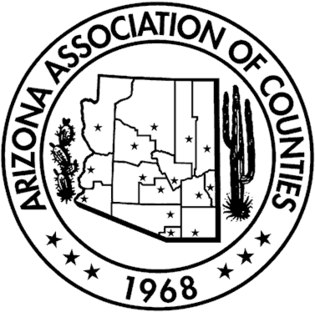
The United States District Court for the District of Arizona is the U.S. district court that covers the state of Arizona. It is under the United States Court of Appeals for the Ninth Circuit.

This is a directory of properties and districts listed on the National Register of Historic Places in Arizona. There are 1,491 listed sites in the state, and each of its fifteen counties has at least ten listings on the National Register. Forty-seven of the state's sites are further designated as National Historic Landmarks.

The Arizona Association of Counties (AACo) was established in 1968 as a member association for all elected officials of Arizona's 15 counties. AACo represents each Arizona county and its elected officials by serving as a liaison to the Arizona State Legislature, United States Congress, other governmental agencies, the media and the public. AACo also sponsors various educational programs and renders professional services for the benefit of its membership and county government.
The Arizona Court of Appeals is the intermediate appellate court for the state of Arizona. It is divided into two divisions, with a total of twenty-eight judges on the court: nineteen in Division 1, based in Phoenix, and nine in Division 2, based in Tucson.

The 2002 congressional elections in Arizona were elections for Arizona's delegation to the United States House of Representatives, which occurred along with congressional elections nationwide on November 5, 2002. Arizona has eight seats, as apportioned during the 2000 United States census and thus gaining two since the previous election. Democrats and Republicans each gained a seat as result, with Republicans having six seats and Democrats having two seats.

The Arizona Department of Homeland Security (AZDOHS) is a state agency within the executive branch of the Arizona state government designed to develop, coordinate, and implement of a state policy to secure the state of Arizona from terrorist threat or attack. AZDOHS manages federal homeland security grants related to terrorism prevention and hazard management.

The 1920 United States presidential election in Arizona took place on November 2, 1920, as part of the 1920 United States presidential election in which all 48 states participated. Arizona voters chose three electors to represent them in the Electoral College via a popular vote pitting Democratic nominee James M. Cox and his running mate, Assistant Secretary of the Navy Franklin Roosevelt, against Republican challenger U.S. Senator Warren G. Harding and his running mate, Massachusetts Governor Calvin Coolidge.

The 1st Arizona State Legislature, consisting of the Arizona State Senate and the Arizona House of Representatives, was constituted from February 14, 1912 to December 31, 1914, during the first term of George Wylle Paul Hunt as Governor of Arizona, in Phoenix. The legislature was heavily skewed towards the Democrats, with their holding a 15–4 lead in the senate, and a 31–4 lead in the Arizona House of Representatives The number of senators and representatives was set by the State Constitution, with 9 counties being granted one Senator, while the other 5 were granted two. Representation in the house was also by county, apportioned by population, with each county being guaranteed a minimum of 1 Representation.

The 1932 United States presidential election in Arizona took place on November 8, 1932, as part of the 1932 United States presidential election. State voters chose three representatives, or electors, to the Electoral College, who voted for president and vice president.

The Sonoran Desert tortoise, or Morafka's desert tortoise, is a species of terrestrial chelonian reptile of the family Testudinidae (tortoises) native to the Sonoran Desert.

Agriculture in Arizona is a notable sector in the state's economy, contributing more than $23.3 billion in 2018. Arizona's diverse climate allows it to export all sorts of commodities such as nuts, wheat, cotton, eggs, meat, and dairy to the United States and 70 other countries. In 2018, the state produced 455.7 million pounds (206.7 kt) of red meat and ranked 3rd in producing vegetables in the United States, occupying 26 million acres of land for farms and ranches combined.

The 1966 Arizona Senate election was held on November 8, 1966. Voters elected all 30 members of the Arizona Senate to serve two-year terms. Following the landmark Reynolds v. Sims (1964) US Supreme Court decision, every state had to redraw state electoral districts to be approximately equal in population. Before Reynolds, the Arizona Senate consisted of 28 members with two elected Senators from each of the state's 14 counties. After the ruling, the Arizona Senate shifted to electoral districts.
The Southwest Border Regional Commission (SBRC) is one of seven federal regional commissions and authorities authorized by the United States Congress to address instances of major economic distress in certain defined socioeconomic regions.

The 1966 Arizona House of Representatives elections were held on November 8, 1966. Voters elected all 60 members of the Arizona House of Representatives in new multi-member districts to serve a two-year term. The elections coincided with the elections for other offices, including Governor, U.S. House, and State Senate.

The 1968 Arizona House of Representatives elections were held on November 5, 1968. Voters elected all 60 members of the Arizona House of Representatives in multi-member districts to serve a two-year term. The elections coincided with the elections for other offices, including Governor, U.S. Senate, U.S. House, and State Senate.
















































